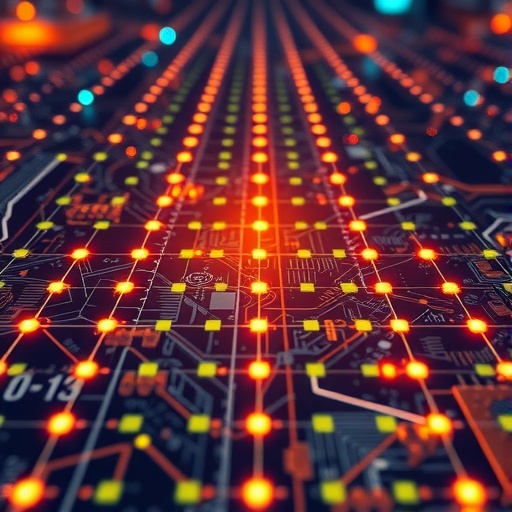In an extraordinary leap forward in our understanding of spatial navigation, a team of neuroscientists has uncovered how grid cells—the brain’s navigational compass—maintain their remarkable ability to track movement precisely, even when the reference frames that underlie spatial representation switch dynamically. This breakthrough challenges long-standing assumptions about the rigidity of internal spatial maps and illuminates the flexible computations that enable animals, including humans, to navigate complex environments with unwavering accuracy.
Grid cells, located in the medial entorhinal cortex, have fascinated scientists since their discovery for their unique firing patterns that form a hexagonal lattice across the spatial environment, effectively creating a coordinate system that allows the brain to encode location. These cells are instrumental in path integration, a process by which animals estimate their current position based on self-motion cues without relying on external landmarks. Traditional models have suggested that grid cell firing patterns are anchored within static reference frames, such as the visual or vestibular ones, and that switching between these would disrupt the coherence of spatial representation. However, the new study, published in Nature Neuroscience, demonstrates that grid cells can dynamically switch reference frames during navigation without losing track of spatial information.
The authors employed state-of-the-art neural recording techniques in rodents navigating virtual reality and real-world environments. By systematically manipulating sensory inputs and reference frames, they observed that despite abrupt shifts in the underlying coordinate system, grid cell ensembles maintained consistent and accurate spatial encoding. This indicates a previously unknown flexibility in the internal computations of the brain’s spatial mapping system, allowing continuous path integration even amid fluctuating contextual information.
The core revelation of the study lies in the discovery that grid cells operate not within a fixed spatial framework but are capable of realigning their firing fields to new frames of reference seamlessly. This is akin to having an internal GPS that can recalibrate itself instantaneously when the map coordinates change, all while keeping track of the user’s trajectory with unwavering precision. Such robustness suggests an advanced hierarchical or multiplexed coding system, wherein grid cells integrate multiple streams of spatial information flexibly rather than passively adhering to a single, constant frame.
Intriguingly, the data reveal that grid cells switch reference frames without degradation in the fidelity of path integration signals, signifying that their network dynamics feature mechanisms to recalibrate or normalize incoming sensory cues rapidly. This is a radical departure from previous concepts that envisioned reference frame switching as a disruptive event leading to ambiguity or errors in spatial representation. Instead, the system appears to embody a form of neural resilience and adaptability critical for real-world navigation where external conditions and sensory inputs frequently change.
Moreover, the findings have profound implications for our understanding of neural coding in spatial cognition. They prompt reconsideration of theoretical models that have predominantly depicted grid cells as invariant anchors of a singular environmental framework. Instead, grid cells emerge as active integrators capable of gating inputs and switching internal reference frames context-dependently, likely mediated by upstream brain regions that coordinate sensory and motor information.
The study also opens enticing avenues linking grid cell dynamics to cognitive flexibility and decision-making. Navigation necessitates updating and revising spatial maps as conditions evolve, such as in novel or ambiguous environments. The ability to switch reference frames intact may underpin such adaptability, enabling the brain to merge external landmarks, proprioceptive signals, and self-motion cues dynamically to maintain coherent situational awareness.
Technical details further reveal that the switching process involves transient patterns of oscillatory synchrony and phase alignment across neural populations, suggesting that temporal coordination plays a pivotal role in reconciling competing spatial signals. This may reflect a broader principle in neural systems where temporal codes—such as theta oscillations modulating grid cell activity—mediate flexible cognitive computations.
Importantly, the research bridges cellular neuroscience with behavioral outcomes by demonstrating that animals successfully navigate mazes requiring shifts in spatial strategies that correspond to switching reference frames. This causal link underscores the ecological relevance of grid cell flexibility, grounding the findings in functional behavior rather than being confined to in vitro or artificial settings.
Beyond basic neuroscience, these insights may have translational potential for addressing human spatial disorientation disorders, such as those witnessed in Alzheimer’s disease and other dementias, where grid cell dysfunction is implicated. Understanding how healthy brains maintain stable navigation despite environmental uncertainties may guide development of therapeutic strategies or neural prosthetics aimed at restoring cognitive map coherence.
Furthermore, the conceptual advance challenges artificial intelligence and robotics fields to reconsider navigation algorithms inspired by biological systems. Current models often rely on fixed coordinate frameworks; integrating flexible reference frame switching, as performed by neural circuits, could enhance autonomous systems’ robustness in complex, dynamic environments.
The authors also discuss the mathematical underpinnings of grid cell remapping. They suggest that internal attractor dynamics within entorhinal circuits allow the geometry of the grid firing pattern to be rotated or translated, effects akin to coordinate transformations in Euclidean space. These continuous transformations enable the neural map to preserve positional integrity despite frame shifts, an elegant solution from both biological and computational perspectives.
Equally notable is that the reference frames involved may correspond to different sensory modalities—visual, vestibular, proprioceptive—or even egocentric versus allocentric spatial perspectives. Grid cells’ ability to integrate and flexibly pivot between these frames underscores their central role as a hub of multisensory spatial computation rather than simple motion encoders.
Overall, this research profoundly alters the conceptual landscape of neural navigation, illustrating that the brain’s spatial GPS is not a rigid system but a flexible, dynamic network finely attuned to environmental contingencies. It invites a reconsideration of foundational assumptions about cognitive maps and provides fertile ground for future studies into the interplay of neural circuits, sensory input, and behavior.
As neuroscience advances, the meticulous elucidation of mechanisms underlying reference frame switching in grid cells will undoubtedly unravel further mysteries about how brains construct a cohesive sense of place and direction amid an ever-changing world. Researchers now have a clearer roadmap to decipher the neural choreography that enables creatures to move effortlessly through space, constantly recalibrating their internal compasses without missing a beat.
Peng, Throm, Najafian Jazi and colleagues’ seminal work thus marks a watershed moment in spatial neuroscience, illustrating the extraordinary flexibility and precision embedded in neural circuits that form the foundation of navigation. Their findings open a window into the elegant computations the brain performs to maintain spatial constancy—an achievement that, until now, seemed nearly impossible in the face of shifting frames of reference.
Subject of Research: Neural mechanisms of spatial navigation and path integration focusing on grid cells and reference frame switching.
Article Title: Grid cells accurately track movement during path integration-based navigation despite switching reference frames.
Article References:
Peng, JJ., Throm, B., Najafian Jazi, M. et al. Grid cells accurately track movement during path integration-based navigation despite switching reference frames. Nat Neurosci (2025). https://doi.org/10.1038/s41593-025-02054-6
Image Credits: AI Generated
Tags: dynamic reference frames in navigationflexible spatial representationgrid cellshexagonal firing patterns in grid cellsinternal spatial mapsmedial entorhinal cortex functionmovement tracking in complex environmentsNature Neuroscience study findingsneural encoding of locationpath integration mechanismsself-motion cues in navigationspatial navigation neuroscience





